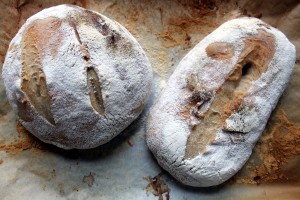 So many of the foods and beverages we enjoy are a result of fermentation. Spirits, wine, and beer, breads, dairy products, tempeh and miso, even olives, tea, and coffee all require bacteria to provide the flavour we love and the nutrients we need.
So many of the foods and beverages we enjoy are a result of fermentation. Spirits, wine, and beer, breads, dairy products, tempeh and miso, even olives, tea, and coffee all require bacteria to provide the flavour we love and the nutrients we need.
From the Latin fervere, which means to boil or bubble, fermentation is the chemical breakdown of an organic substance by enzymes which are released when bacteria and yeasts feed on them. Different types of fermentation produce various foods and beverages, but fermentation usually describes the conversion of starches and sugars into ethyl alcohol and bubbles of carbon dioxide gas.
A jug of wine, a loaf of bread
Alcohol fermentation has been used to produce beer from starches and wines from fruit sugars for more than 7,000 years. In turning wine to vinegar, bacteria known as Acebacteraceti help fermented grapes react with oxygen in the air in order to form acetic acid. Most vinegars range from 4.5 to 9 percent acetic acid.
In plain bread, the main flavouring components are ordinary baker’s yeast and acids produced by bacteria. In the sourdough loaf, a sourdough starter made from airborne strains of yeast and bacteria is used to leaven the dough. In traditional bread making, yeasts usually outnumber bacteria; whereas in sourdough bread, their balanced proportions allow plenty of acid-forming bacteria to be present. The acids guarantee a good shelf life because the acidic dough inhibits mold growth.
Yogourt is fermented, too
Yogourt, sour cream, cottage cheese, and buttermilk are, after cheese, the most widely eaten dairy products. They differ from most cheeses in that they are not coagulated with rennet (a preparation made from the stomach membrane of a calf). Instead, these dairy products are thickened by the action of acid-producing bacteria. They’re more fabulous fermented foods.
The first yogourt was created accidentally. When left alone, fresh milk quickly teems with lactic acid bacteria that sour it. As long as fermentation occurs, the resulting thick texture and tart taste contains all the nutritional benefits of milk.
The original buttermilk was also a fermented food. Buttermilk – the low-fat liquid left over from making butter – was prepared by allowing milk to be contaminated by airborne bacteria during the churning. The milk thickened and soured, producing buttermilk that is quite different from the commercial product we buy today.
When the previously used containers were reused, it was found that the bacteria culture could be perpetuated. Adding a small amount of the previous batch guaranteed further results. Sour cream, clotted cream, and crème fraiche were also made by adding previous batches of bacteria culture to the high-fat portion of milk.
The use of bacteria and fermentation in our favourite foods and beverages is worldwide. What a wonderful legacy.



